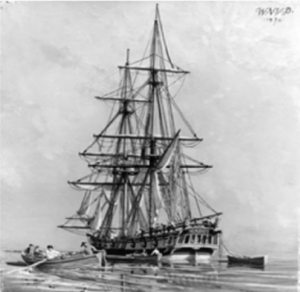Battle off Yarmouth (1777) facts for kids
Quick facts for kids Battle off Yarmouth (1777) |
|||||||
|---|---|---|---|---|---|---|---|
| Part of the American Revolutionary War | |||||||
 USS Cabot |
|||||||
|
|||||||
| Belligerents | |||||||
| Commanders and leaders | |||||||
Lieut. Benjamin Knight |
|||||||
| Strength | |||||||
| 140 men | 32 guns | ||||||
The Battle off Yarmouth took place on 28 March 1777 during the American Revolutionary War off the coast of Yarmouth, Nova Scotia. The battle is the first American armed vessel to engage the British Navy. The British vessel HMS Milford forced the American USS Cabot aground and the American crew escaped among the inhabitants of Yarmouth.
Background
During the American Revolution, Americans regularly attacked Nova Scotia by land and sea. American privateers devastated the maritime economy by raiding many of the coastal communities, such as the numerous raids on Liverpool and on Annapolis Royal.
Battle
Three American vessels (brigantines) – Massachusetts (Captain John Fisk), Tyrannicide (Captain Jonathan Harriden) and the brig Cabot (Captain Olney) - were sailing toward Nova Scotia and were confronted at 11:00 pm by HMS Milford. They waited until morning before they decided to attack. During the morning hours Cabot had been separated from the other two ships. Then the weather became "thick and rainy" until 6:00 pm. When the weather cleared Milford pursued Cabot. The wind and waves remained high and the pursuit lasted for several days and nights. Captain Olney realized Cabot was being overtaken and steered to the Nova Scotia shore and beached the vessel near Chebogue River, a short distance from Yarmouth.
Aftermath
The crew of 140 got safely to shore and escaped into the village of Chebogue. Local residents Captain Zacharias Foot and his nephew Captain Richard Valpey housed and fed thirty of the crew for a few weeks until they were able to secure a vessel back to Portsmouth, New Hampshire. One observer noted that Captain Foot's "unbounded liberality to American prisoners is Well known to many." On separate occasions, Foot and Valpey were later imprisoned by the Americans. Captain Olney advocated for Foot's release, which was successful. After this period, Foot continued to trade with Boston the release of American prisoners for other goods and supplies. American privateers remained a threat to Nova Scotian ports for the rest of the war. For example, after a failed attempt to raid Chester, Nova Scotia, American privateers struck again in the Raid on Lunenburg in 1782.
Milford took 14 days to get Cabot afloat and then sent it to Halifax.

